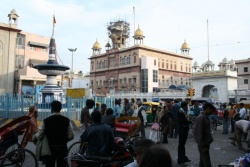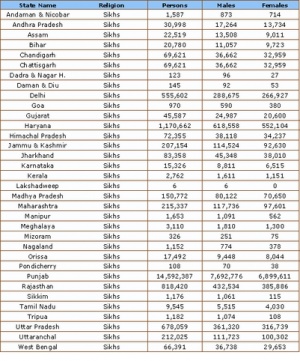Sikhism in India: Difference between revisions
No edit summary |
No edit summary |
||
| Line 44: | Line 44: | ||
|# ||'''State''' ||'''Total''' ||'''Males''' ||'''Females''' | |# ||'''State''' ||'''Total''' ||'''Males''' ||'''Females''' | ||
|- | |- | ||
|1 || | |1 ||Andaman & Nicobar Islands ||1,587 ||873 ||714 | ||
|- | |- | ||
|2 ||Andhra Pradesh ||30,998 ||17,264 ||13,734 | |2 ||Andhra Pradesh ||30,998 ||17,264 ||13,734 | ||
Revision as of 06:56, 21 June 2008
Sikhism has been in India for over 500 years, beginning with the birth of its founder Guru Nanak Dev. The Sikhs are predominately located in Punjab, but also in many other parts of India and the world.
The birth of the Sikh religion
About 2% of India's population are Sikhs. Even so, the Sikhs, because of their unique appearance sometimes stand for India. Traditionally the men keep their hair and do not shave their beard or moustache. They gather their head hair in a turban. Sikhism is comparatively a new religion in India. This religion was established by Guru Nanak. Nanak was born into a Hindu family in 1469 in the Punjab region. Since childhood he loved to travel, learn and preach humanity. In those days people who taught and preached were titled Guru meaning teacher, his followers became to be known as Sikhs meaning learners. And so Guru Nanak developed a new religion and it also included beliefs from the two dominant religions in the Punjab region, Hinduism and Islam. Some claim that Guru Nanak tried to developed a new religion and included in it what he thought were the good beliefs of these two religions.[1]
The creators of Sikhism tried to abolish some of the Indian customs such as the caste system and Sati (practice) - burning of the widow. In Sikhism everyone has equal rights irrespective of caste, creed, color, race, sex or religion. Sikhism rejects pilgrimage, fasting, superstitions and other such rituals. Sikhism does not have a clergy class as it considers this as a gateway to corruption. However, they have readers and singers in their temples.
The Sikh Gurdwara
A Sikh place of worship is called Gurdwara. Sikhism does not support pilgrimage to holy sites because according to Sikhism, God is everywhere and not in any certain place. But Sikhism has a few important sites, of which, the Harmandar, also known as the 'Golden Temple' in Amritsar in Punjab is the most important site and is considered the holiest shrine of Sikhism.
Langar (the communal meal)
Sikhism emphasis community services and helping the needy. One of the distinct features of Sikhism is the common kitchen called Langar. In every Gurdwara there is a Langar. Every Sikh is supposed to contribute in preparing the meals in the free kitchen. The meals are served to all and are eaten sitting on the floor and this is to emphasis the point that all are equals. Sikhism does not believe in holding fasts for body is God's present to human being and therefore humans must foster, maintain and preserve it in good sound condition, unless fasting is done to foster the human body like healthy diets.
The Guru Granth Sahib
Guru Nanak who established Sikhism was its first Guru. After him there were nine more Gurus who were the highest religious authority. The last Guru, Guru Gobind Singh, proclaimed that after him the Guru of the Sikhs would be the holy book of Sikhism, Guru Granth Sahib.
Guru Granth Sahib is written in Gurmukhi script. It includes the writings of the Sikh Gurus and the writings of Hindu and Muslims saints. But out of humility Guru Gobind Singh did not include his own writings in the book he had proclaimed as the permanent Guru of the Sikhs. His writings appear in a separate book called Dasam Granth. Guru Gobind Singh is also the Guru behind the unique appearance of Sikh men.
Sikhs combat with the Mughals
During Guru Gobind's term as the Guru of the Sikhs and also before him, the ruling empire of Punjab region was the Mughal Empire. The Mughals were Muslims. Some of the Moghul emperors, like Aurangazeb were fanatic Muslims who harassed the non- Muslims mainly hindus and tried to convert them to muslims.Sikh Guru Teg Bahadur Sahib saved Hindu from Muslims and He named as Hind Di Chadar. In order to stop their persecutions, Guru Gobind decided to make his followers, the Sikhs (meaning learners), a community of fighters. He changed his surname to Singh, which means lion. His followers also changed their surname to Singh. Since then a ceremony of baptizing was established among the Sikhs in which the boys were given the title Singh and the girls were titled Kaur meaning princess. In those days "Singh" as a surname was very popular among a famous warrior caste of north India, the Rajputs. Some of the first Sikhs were also Rajputs.
Creating an Identity for the Sikhs

In order to make it easier for his followers to recognize each other, Guru Gobind Singh, chose five marks, some of which even today symbolize the Sikhs. The five signs were, uncut hair Kesh; bracelet on the right hand wrist Kara; comb Kanga shorts Kaccha and sword or dagger Kirpan;. The religious Sikhs dress according to Guru Gobind Singh's order, carrying a sword (kirpan). Most of the Sikhs even today have uncut hair and gather it in a turban. But some easygoing Sikhs cut their hair or they do not gather their uncut hair in a turban.
The emphasis on militant tradition and community service in Sikhism continues even today and many Sikhs serve in the Indian army or police. The Sikhs also have a reputation as experts in steering, from cars to airplanes.They were among the first communities in India who dared to drive vehicles specially lorries. India being a vast country needed drivers who could also travel at nights. But many Indians believed in superstitions like ghosts and haunted places, while the Sikhs rejected these kinds of beliefs and therefore traveled at nights, since then their reputation as steering masters of India."
Punjabi Suba
- Main article: Punjabi Suba
1984 Anti Sikh massacre
- Main article: 1984 Anti-Sikh riots
The 1984 Anti-Sikh Massacre took place in India after the assassination of Indira Gandhi on October 31, 1984. India's Prime Minister Indira Gandhi was assassinated by two of her Sikh guards acting in the aftermath of Operation Bluestar. After the Prime Minister's death next 4 days became one of the most brutal times for the Sikhs because they were being attacked by the Congress mobs who were instigated by the Congress politicians.
Sikh population by each Indian state
| # | State | Total | Males | Females |
| 1 | Andaman & Nicobar Islands | 1,587 | 873 | 714 |
| 2 | Andhra Pradesh | 30,998 | 17,264 | 13,734 |
| 3 | Arunachal Pradesh | 1,865 | 1,475 | 390 |
| 4 | Assam | 22,519 | 13,508 | 9,011 |
| 5 | Bihar | 20,780 | 11,057 | 9,723 |
| 6 | Chandigarh | 145,175 | 76,000 | 69,175 |
| 7 | Chhattisgarh | 69,621 | 36,662 | 32,959 |
| 8 | Dadra & Nagar Haveli | 123 | 96 | 27 |
| 9 | Daman & Diu | 145 | 92 | 53 |
| 10 | Delhi | 555,602 | 288,675 | 266,927 |
| 11 | Goa | 970 | 590 | 380 |
| 12 | Gujarat | 45,587 | 24,987 | 20,600 |
| 13 | Haryana | 1,170,662 | 618,558 | 552,104 |
| 14 | Himachal Pradesh | 72,355 | 38,118 | 34,237 |
| 15 | Jammu & Kashmir | 207,154 | 114,524 | 92,630 |
| 16 | Jharkhand | 83,358 | 45,348 | 38,010 |
| 17 | Karnataka | 15,326 | 8,811 | 6,515 |
| 18 | Kerala | 2,762 | 1,611 | 1,151 |
| 19 | Lakshadweep | 6 | 6 | 0 |
| 20 | Madhya Pradesh | 150,772 | 80,122 | 70,650 |
| 21 | Maharastra | 215,337 | 117,736 | 97,601 |
| 22 | Manipur | 1,653 | 1,091 | 562 |
| 23 | Meghalaya | 3,110 | 1,810 | 1,300 |
| 24 | Mizoram | 326 | 251 | 75 |
| 25 | Nagaland | 1,152 | 774 | 378 |
| 26 | Orissa | 17,492 | 9,448 | 8,044 |
| 27 | Pondicherry | 108 | 70 | 38 |
| 28 | Punjab | 14,592,387 | 7,692,776 | 6,899,611 |
| 29 | Rajasthan | 818,420 | 432,534 | 385,886 |
| 30 | Sikkim | 1,176 | 1,061 | 115 |
| 31 | Tamil Nadu | 9,545 | 5,515 | 4,030 |
| 32 | Tripura | 1,182 | 1,074 | 108 |
| 33 | Uttar Pradesh | 678,059 | 361,320 | 316,739 |
| 34 | Uttaranchal | 212,025 | 111,723 | 100,302 |
| 35 | West Bengal | 66,391 | 36,738 | 29,653 |
Sikh Population by region
| # | Region | Total |
| 1 | North India | 18,821,957 |
| 2 | Andhra Pradesh | 30,998 |
| 3 | Arunachal Pradesh | 1,865 |
| 4 | Assam | 22,519 |
| 5 | Bihar | 20,780 |
| 6 | Chandigarh | 145,175 |
| 7 | Chhattisgarh | 69,621 |
| 8 | Dadra & Nagar Haveli | 123 |
| 9 | Daman & Diu | 145 |
| 10 | Delhi | 555,602 |
| 11 | Goa | 970 |
| 12 | Gujarat | 45,587 |
| 13 | Haryana | 1,170,662 |
| 14 | Himachal Pradesh | 72,355 |
| 15 | Jammu & Kashmir | 207,154 |
| 16 | Jharkhand | 83,358 |
| 17 | Karnataka | 15,326 |
| 18 | Kerala | 2,762 |
| 19 | Lakshadweep | 6 |
| 20 | Madhya Pradesh | 150,772 |
| 21 | Maharastra | 215,337 |
| 22 | Manipur | 1,653 |
| 23 | Meghalaya | 3,110 |
| 24 | Mizoram | 326 |
| 25 | Nagaland | 1,152 |
| 26 | Orissa | 17,492 |
| 27 | Pondicherry | 108 |
| 28 | Punjab | 14,592,387 |
| 29 | Rajasthan | 818,420 |
| 30 | Sikkim | 1,176 |
| 31 | Tamil Nadu | 9,545 |
| 32 | Tripura | 1,182 |
| 33 | Uttar Pradesh | 678,059 |
| 34 | Uttaranchal | 212,025 |
| 35 | West Bengal | 66,391 |
References
External links
- See Wikipedia article on Sikhism in India for more information
| Gurus: | Nanak Dev | Guru Angad | Amar Das | Ram Das | Guru Arjan | Har Gobind | Har Rai | Har Krishan | Tegh Bahadur | Gobind Singh | Guru Granth Sahib | Sikh Bhagats |
| Philosophy: | Sikh Beliefs | Simran | Sewa | Beliefs and Principles | Underlying Values | Prohibitions | Technique and Methods | Other observations | Technique and Methods |
| Practices: | Ardas | Amrit Sanskar | Chardi Kala | Dasvandh | Five Ks | Kirat Karni | Kirtan | Langar | Naam Japna | Simran | Three Pillars | Vand Chakna | Five Evils | Five Virtues |
| Scripture: | Guru Granth Sahib | Sikh Scripture | Dasam Granth | Ek Onkar | Waheguru | Bani | Mool Mantar | Japji Sahib | Jaap Sahib | Chaupai | Anand Sahib | Tav-Prasad Savaiye | Rehras | Sukhmani |
| More: | History | Gurdwaras | Harmandir Sahib | Khalsa | Khanda | Names | Places | News | Satguru | Sikhs | Bhagat Farid | Bhagat Kabir | Websites | Biographical | Terms |



